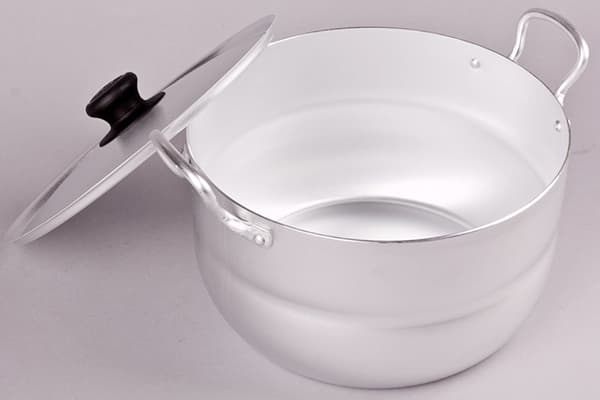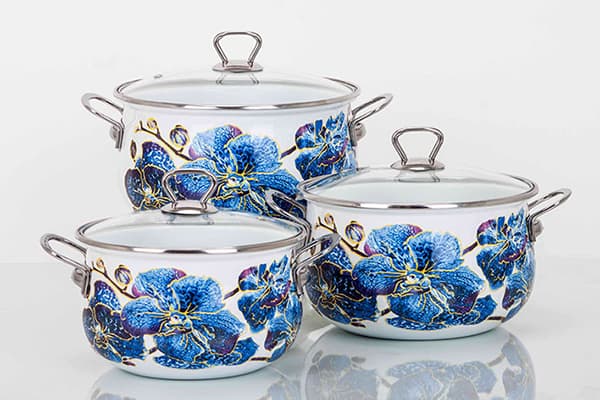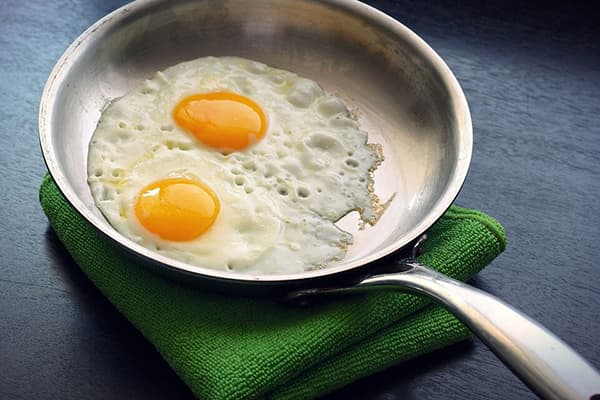Aluminum cookware is harmful to health – another lie or the truth?
Aluminum cookware is found in almost every kitchen today. It’s just that modern technologies make it possible to produce it with an attractive appearance, which consumers do not always recognize as this metal. But many people are afraid to buy “obvious aluminum” because of the established opinion that it can be dangerous to our health. How harmful is it really to cook in aluminum cookware?

Attractive properties of aluminum
Our mothers and grandmothers used such utensils very actively until the idea of their harm gained popularity. Why were such pots and pans so attractive to housewives?
- Aluminum utensils are very light, easy to rearrange during cooking, easy to wash, and conveniently stacked on shelves for storage.
- Such dishes are affordable.
- It is not subject to corrosion – that is, it will not rust.
- The undeniable benefit of aluminum is its excellent thermal conductivity, which ensures uniform heating of food and makes it possible to cook food much faster without spending extra time heating the container itself. In addition, the risk of burning in such pots or pans is lower than, for example, in enameled ones.
Aluminum cookware of the “older generation” was most often made from pure aluminum, which is why it was frankly soft and deformed quite quickly. Modern technologies make it possible to produce it in the form of harder alloys with magnesium, silicon, steel, and cast iron.Cast iron alloy guarantees long-term heat retention, and steel alloy guarantees higher strength and durability of such utensils.
Debunking myths
The main prejudice that forces housewives to prefer more expensive aluminum utensils made from other materials is the assertion that aluminum can have a harmful effect on our health. Is it really? Not at all. And that's why.
Direct contact of products with aluminum during cooking is practically excluded due to the presence of a thin oxide layer that forms on the surface of the metal naturally when it comes into contact with oxygen. Sometimes it is created forcibly in production, using the anodizing method - this oxide layer is thicker and more reliable.
Recently, scientists have proven that the maximum “portion” of metal that can enter food during cooking is not higher than 3 mg. And the volume dangerous to human health is 10 times greater. Even taking into account the fact that we get some amount of aluminum every day from food and water, this is a completely harmless amount.
In addition, the World Health Organization has proven that aluminum is a non-carcinogenic metal. Accordingly, all fears that it can cause cancer are completely unfounded.
So everyone who was against aluminum in the kitchen should at least reconsider their views.
And the established stereotype that such dishes have a “official” appearance is not true today: they are produced with very decorative external coatings that do not have direct contact with the products and, accordingly, do not affect their properties, but give the dishes themselves a modern , expensive look. For example:
- product-safe varnish;
- tableware enamel;
- porcelain suspension.
Of course, such pots or pans are a little more expensive than those that do not have a decorative coating, but dishes with a durable decorative coating will not fade over time. The choice between them, as they say, is a matter of taste and opportunity.
What exactly is the harm?
Anything can be harmful under one important condition: improper use. The same rule applies to aluminum cookware. If several important conditions of use are not met, the oxide layer is destroyed, and direct contact of the metal with food begins, which can have a bad effect on the human body (although there is still no talk of provoking oncology).
The worst thing that can happen is food poisoning. What actions of ours lead to this?
- Cooking dishes containing acidic ingredients (lemon, vinegar, tomatoes, sour fruits) in such dishes. That is, meat marinated in vinegar (or even kefir) cannot be fried in an aluminum frying pan. And you cannot cook compotes, jelly, preserves, or borscht in aluminum pans. However, there is one loophole to this rule: if the pot or pan has a non-stick coating, direct contact of food with aluminum is eliminated, and cooking acidic foods becomes safe. At the same time, all the beneficial properties of the metal are preserved. But the prepared dish must be immediately transferred to another container.
- Using aluminum containers for salting, fermenting and marinating products. After all, even if the recipe does not contain citric acid or vinegar, acid will inevitably be formed during the process of pickling or fermentation.Accordingly, the oxide layer will quickly collapse, and products will begin to react with aluminum, forming harmful compounds and increasing the concentration of aluminum itself in food.
- Long-term storage of prepared dishes in aluminum containers. This leads to the fact that the products still destroy the protective layer and react with the metal. The consequences of this are described above.
- Using abrasive substances or steel wool to clean such utensils. This leads to the rapid destruction of the oxide layer and damage to the internal surface, which can cause an increase in the amount of metal entering the food. Aluminum should only be cleaned with soft sponges and liquid dishwashing detergent. If something is burnt to such dishes, it is better to soak them for several hours or even overnight, but do not rub them with sand, a wire brush or other scratching agents or objects.
If you only have an aluminum pan of suitable size for pickling, put all the ingredients in two plastic bags and then lower them into the container. In this case, contact with metal will be avoided, and your products will not be damaged. However, there is one more condition: the inner surface of such dishes should not have burrs, roughness or other damage that could tear the bags, for example, during mixing. If this happens, you will have to urgently “relocate” the workpieces to another container.
What can you cook?
As is already clear, you can cook any dishes for which no acids are used (vegetables, fruits, lactic acids, vinegar). This can be various cereals and soups, potatoes (either mashed in a saucepan or fried in a frying pan), non-acidic vegetables, dairy dishes, any pasta, fish, meat, eggs, mushrooms.
So, contrary to the established “reinforced concrete” stereotype about terrible diseases caused by the use of aluminum cookware, in fact there is nothing terrible or harmful about it. If, of course, you follow the basic rules of use. And they are not that complicated.




Aluminum cookware is dangerous not because of the formation of tumors, but because it leads to Alzheimer's disease. Here is a quote from Wikipedia: Some studies suggest an increased risk of developing Alzheimer's disease in people whose work involves exposure to magnetic fields[133][134], exposure to metals, especially aluminum[135][136], or use of solvents[133][134]. 137]. Some of these publications have been criticized for their poor quality of work[138], and other studies have found no association of environmental factors with the development of Alzheimer's disease[139][140][141][142].
“Recently, scientists have proven that the maximum “portion” of metal that can enter food during cooking is not higher than 3 mg. And the volume dangerous to human health is 10 times greater.”
A volume hazardous to health is a dose at which POISONING will occur IMMEDIATELY. Damage from dishes accumulates GRADUALLY, over the years, unnoticed by the body. The comparison is far-fetched.
Dishes with varnish, enamel, or suspension have the properties of enamel dishes. It no longer has the advantages of aluminum.
Alexander, yes, I agree. It accumulates. And it is quite reactive if the oxide film is removed. In addition, with chronic intoxication with aluminum, parkinsonism occurs, similar to manganese in welders. One bowl of borscht contains the daily maximum permissible concentration. So it’s better not to cook sour, spicy, etc. Especially if it lasts for several days. Or the following not entirely correct example. Make a concentrated solution of copper sulfate, add al. wire. Nothing happens. As soon as you throw in a pinch of table salt, there is a rapid release of hydrogen, and the film disintegrates. At the micro level, food acids and alkalis act in this way.
,,,,, and American researchers claim that over the past 200 years, the length of the tail of domestic cats has increased by 2 centimeters. Global warming is probably to blame?????
What’s the problem, a set of cookware made of food-grade stainless steel with a triple bottom, where there is an aluminum layer and the last layer for induction, is modern, durable, safe and technologically advanced.
The problem is the price.
Remember chemistry at school. Aluminum does not interact with acids, but only with alkalis. So you can safely prepare compotes, jam and cabbage soup from sauerkraut. If it were the other way around, then old aluminum cookware would be eaten away by corrosion.I didn't go like that. Manufacturers need expensive and short-lived products. Learn chemistry.
take an aluminum spoon, immerse it in an acid SOLUTION, the salts of which dissolve in water, scratch the spoon with a nail and calmly observe the release of hydrogen. Learn chemistry/
I don’t know about cabbage soup. I don’t know about compotes, but I cooked the meat in sour sauce in an aluminum cauldron. I got poisoned like that. I don’t know how I stayed alive—I didn’t even take a glass of water in my stomach for two weeks. Only now do I understand how close I was to death. And you write “does not react with acids.”
And with acids, and with alkalis, and with water in the presence of acids and alkalis. Where did you study chemistry?
definitely no aluminum. threw everything away
Acceleration among those born in the 50s and 60s was blamed on aluminum dishes... and the facts were given
Personally, I stopped cooking with it a long time ago
And I think, why did our ancestors live to be 100 years old? — It turns out they were etched with aluminum. Enameled dishes were more expensive and not available to everyone. It's all about quality and concern for people's health. The capitalist will not care about people, the main thing for him is to hit the jackpot. Are you sure that all these newfangled trends are not harmful? Remember Khrushchev’s words that in the USSR they will not eat from plastic and polyethylene dishes because they are toxic, but now everything has been filled with them and they have polluted the environment. They started to “fight” landfills at the expense of the people, but wouldn’t it be easier to ban the production of all sorts of nasty things? Probably there were idiots in the USSR - they produced reusable glass containers, packaged them in paper that could be burned, had string bags, bags made of durable material? - No, they just looked a little further than their nose and there was no such ugliness.
My aunt used aluminum cookware her entire adult life and lived a long life without getting sick.
The best saucepan for boiling milk and preparing porridge in small quantities.
Aluminum cookware is safe as long as you do not clean it with abrasives or meth. sponges.
If aluminum pots are so harmful to health, why are kindergartens still cooking food? All this is anti-advertising for people to buy foreign toxic stainless steel.
Sanpin prohibits the use of aluminum utensils in children's institutions.
Sanpin can be, look in almost any kindergarten kitchen - they cook in large aluminum pans the same way they cook in catering canteens - and there they are...
What about aluminum foil? When baking and seasoning, a lot of different things are used and the temperature may be higher in the oven, and the finished product can be stored longer in this “packaging”.
Horror stories about aluminum cookware were quite possibly invented by manufacturers of expensive stainless steel cookware. We have an aluminum saucepan, which is about 60 years old, used for cooking vegetables such as jacket potatoes, so I didn’t notice any holes or deep cavities in it from “dissolved” aluminum.
But what about the same compote in kindergartens and schools? I don’t know a single person who fell ill with some kind of disease from clean aluminum utensils. But how many years of camping and fishing has it been cooked and eaten? I doubt it’s harmful, but in the army - a bowler hat, a flask - How is that.
In America, aluminum cookware is not sold - it is prohibited. And with us - please
Everything can be promoted. So freon was innocently accused of destroying the ozone layer. The holes are on their own, the freon is on its own.
With this approach to assessing harm, it is possible to prove the harmlessness of lead cookware.
In my time, rumors were heavily debated that aluminum was to blame for acceleration...
These are matters of taste and trust. I was born in the USSR, everything that was there was real, but now... g... but! And we just wave our manes that we agree to everything. I don’t see anything bad in aluminum, as long as it’s real.
Previously, EVERYTHING was cooked in aluminum! No one got sick or poisoned! Now everything has become bad, which was used by our ancestors, who lived to be 90 or more years old!!!! Is aluminum bad? Has anyone studied these modern coatings and metal???? ! This is where they cause harm!!!! And the plastic?????
Who here in the USSR all lived to be 90? died as now or even before. why make up lies? Moreover, diseases were diagnosed and treated worse, now there are definitely more opportunities.
But the food in stores now is bad, and more or less expensive.
I still have a couple of aluminum pans. It would be a shame to throw them away, they are in good condition. I cook different dishes in them, but they do not contain acid.